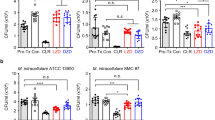Abstract
The intracellular growth kinetics ofMycobacterium xenopi was studied in the murine J-774 macrophage cell line model. During the initial 4 days of infection, the bacilli divided about every 33 h. Electron microscopy of infected macrophages showed that bacteria inside phagosomes were surrounded by a protective electron-transparent zone (ETZ). This model was used for comparing the extracellular and intracellular activities of the following drugs: pristinamycin (PRISTINA), isoniazid (INH), clofazimine (CLOFA), rifabutin (=ansamycin; ANSA), rifampicine (RIFA), streptomycin (SM), ethambutol (EMB), and five fluoroquinolones, namely, ciprofloxacin (CIPRO), ofloxacin (OFLO), pefloxacin (PEFLO), enoxacin (ENOX) and norfloxacin (NORFLO). All the drugs were tested within their obtainable serum level concentrations in man. Under these conditions, CLOFA, SM, CIPRO, and OFLO were highly active against intracellularly growingM. xenopi, INH and RIFA were moderately active, whereas ANSA, PRISTINA, EMB, PEFLO, ENOX, and NORFLO were only growth inhibiting. The comparison of these data with extracellular activities of the same drugs underlined the discrepancies observed in test-tube drug activity evaluation and its correlation with results of chemotherapy in patients in whom the drug has essentially an intracellular bacterial killing role.
Similar content being viewed by others
Literature Cited
Bank J, Hunter AM, Campbell JA, Jenkins PA, Smith AP (1984) Pulmonary infection withMycobacterium xenopi: review of treatment and response. Thorax 39:376–382
Beck A, Stanford JL (1968)Mycobacterium xenopi: a study of sixteen strains. Tubercle 49:226–234
Bullin CH, Tanner EI, Collins CH (1970) The isolation ofMycobacterium xenopi from water taps. J Hyg (Camb) 68:97–100
Contreras MA, Cheung OT, Sanders DE, Goldstein RS (1988) Pulmonary infection with nontuberculous mycobacteria. Am Rev Resp Dis 137:149–152
Costrini AM, Mahler DA, Gross WM, Hawkins JE, Yesner R, D'Esopo ND (1981) Clinical and roentgenographic features of nosocomial pulmonary disease due toMycobacterium xenopi. Am Rev Resp Dis 123:104–109
Damsker B, Bottone EJ, Deligdisch L (1982)Mycobacterium xenopi infection in an immunocompromised host. Human Pathol 13:866–870
DesBordes-Lize J, Fouye G, Lelieur G (1970) Contribution à l'étude deMycobacterium xenopi à l'occasion d'une importante endémie hospitalière. Poumon Coeur 26:1141–1182
Elston HR, Duffy JP (1973)Mycobacterium xenopi and mycobacteriosis: a clinical and bacteriologic report. Am Rev Resp Dis 108:944–949
Eng RH, Forrester C, Smith SM, Sobel, H (1984)Mycobacterium xenopi infection in a patient with acquired immunodeficiency syndrome. Chest 86:145–147
Engbaek HC, Vergmann B, Baess I, Will DW (1967)Mycobacterium xenopi: a bacteriological study ofM. xenopi including case reports of Danish patients. Acta Pathol Microbiol Scand 69:576–594
Good RC, Snider DE (1982) Isolation of nontuberculous mycobacteria in the United States in 1980. J Infect Dis 146:829–833
Gross WM, Hawkins, JE, Murphy DB (1976) Origin and significance ofMycobacterium xenopi in clinical specimens. I. Water as a source of contamination. Bull Int Union Tuberc 51:267–269
Horak Z, Polakova H, Kralova M (1986) Water-borneMycobacterium xenopi: a possible cause of pulmonary tuberculosis in man. J Hyg (Praha) 30:405–409
Lemercier JP, Morel A, Savigny G, Thièrry C, Lambert J (1979) Étude de 960 souche deMycobacterium xenopi isolées en Seine-Maritime pendant 12 années. Rev Franç Mal Resp 7:510–512
Marks J, Schwabacher H (1965) Infection due toMycobacterium xenopi. Br Med J 1:32–33
McClatchy JK (1980) Antituberculous drugs: mechanisms of action, drug-resistance, susceptibility-testing, and assays of activity in biological fluids, In: Lorian V (ed), Antibiotics in laboratory medicine. Baltimore: William and Wilkins, pp 135–169
McSwiggan DA, Collins CH (1974) The isolation ofMycobacterium kansasii andM. xenopi from water systems. Tubercle 55:291–297
Rastogi N, Fréhel C, David HL (1986) Triple-layered structure of mycobacterial cell wall: evidence for the existence of a polysaccharide-rich outer layer in 18 mycobacterial species. Curr Microbiol 13:237–242
Rastogi N, Potar MC, David HL (1987) Intracellular growth of pathogenic mycobacteria in the continuous murine macrophage cell line J-774: ultrastructure and drug-susceptibility studies. Curr Microbiol 16:79–92
Rastogi N, Goh KS, David HL (1988) Activity of five fluoroquinolones againstMycobacterium avium-intracellulare complex andM. xenopi. Ann Inst Pasteur/Microbiol 139:233–237
Simor AE, Salit IE, Velland H (1984) The role ofMycobacterium xenopi in human disease. Am Rev Resp Dis 129:435–438
Wise R, Griggs D, Andrews JM (1988) Pharmacokinetics of the quinolones in volunteers: a proposed dosing schedule. Rev Infect Dis 10 (Suppl 1):S83-S89
Wolinsky E (1979) Nontuberculous mycobacteria and associated diseases. Am Rev Resp Dis 119:107–159
Yajko DM, Nassos PS, Hadley WK (1987) Therapeutic implications of inhibition versus killing ofMycobacterium avium complex by antimicrobial agents. Antimicrob Agents Chemother 31:117–120
Author information
Authors and Affiliations
Rights and permissions
About this article
Cite this article
Rastogi, N., Blom-Potar, MC. & David, H.L. Drug action against intracellularly growingMycobacterium xenopi . Current Microbiology 19, 83–89 (1989). https://doi.org/10.1007/BF01570573
Issue Date:
DOI: https://doi.org/10.1007/BF01570573




